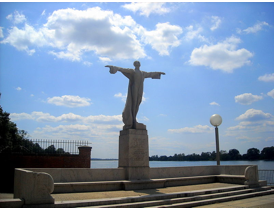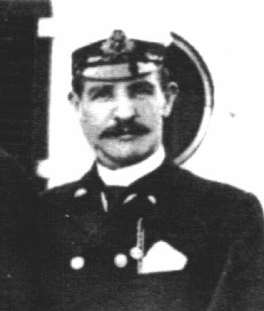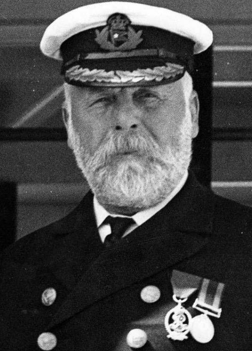A Night (Not to Forget)

(The Titanic Memorial on the placid banks of the Potomac, Washington’s gateway to the world ocean. The statue, carved from a single block of granite, depicts a partially clothed First Class male passenger. Photo Wikipedia.)
Sorry campers, this is late. AOL, that creaky excuse for an e-mail system, got me this morning. No pictures meant no story, at least at the usual time. But better late than never? You be the judge.
You can’t get away from it this week, and yesterday the tide of memory finally swept over me, along with a dollop of bile. History is never “settled science,” I guess. The sinking of the most modern ocean-liner ever built on her maiden voyage, with one of the most veteran skippers on the bridge. The “A” list of passengers, the slow motion unfolding the disaster.
Downtown there was a ceremony at the Titanic Memorial. The inscription it to those who did their duty, stayed behind, and ensured that women and children got on the boats first. The words on the front of the memorial read:
TO THE BRAVE MEN
WHO PERISHED
IN THE WRECK
OF THE TITANIC
APRIL 15 1912
THEY GAVE THEIR
LIVES THAT WOMEN
AND CHILDREN
MIGHT BE SAVED
ERECTED BY THE
WOMEN OF AMERICA
Back:
TO THE YOUNG AND THE OLD
THE RICH AND THE POOR
THE IGNORANT AND THE LEARNED
ALL
WHO GAVE THEIR LIVES NOBLY
TO SAVE WOMEN AND CHILDREN
The memorial has moved around a bit, unlike Titanic herself, scattered in a twenty-five square mile debris field around two major chunks of her once impressive hull. The Women of America originally place the sculpture at the foot of New Hampshire Avenue in Rock Creek Park. It was moved down river without ceremony to the edge of Fort Leslie J. McNair when the Kennedy Center was built in 1966.
Maybe the lack of pomp on the relocation is symptomatic of something else. The sentiments are a little schmaltzy by today’s standards, and the narrative of the death of a great ship has been hijacked to tell another story. Dedicated in 1931, by the widow of President Taft.
There was something about this version of history that was recounted in Walter Lord’s vivid re-telling of the narrative in his 1955 book “A Night to Remember,” and Kenneth More’s 1957 film adaptation of the same name. In these versions of the sinking, the riveting drama of the sinking holds a “tragic yet peculiarly reassuring story that points to lost certainties, a story of British identity, imperial ambition, engineering bravado, and structured social class.”
I liked both. But I am boycotting the re-release of James Cameron’s bloated film “Titanic” in 3-D. I went to see it in the first release and I think I enjoyed it. But the number of things wrong with it from a historical perspective are astonishing in their mendacity.
I heard that when Chinese president Jiang Zemin watched the first release of the movie, he smiled, “Gentlemen, behold the enemy.” For him and many Americans, the movie’s cloying, cowardly first class passengers represent that capitalistic ethic.”
The matter of the lifeboats is the pivot on which James Cameron transforms a tale of stoic courage by most of the First Class male passengers into a narrative on class warfare. I boycotted his blockbuster film “Avatar” since with vast wealth has come his ability to re-write both past and future history.
Mr. Cameron is a despicable fellow when it comes to integrity. The storyline of “Avatar” was stolen from an ancient (1957) pulp sic-fi story by Poul Anderson, which I read in the pages of Amazing Stories in the first edition. Anderson’s story “Call Me Joe” was ripped off without attribution and injected with blatant anti-American theme, masquerading as a treatise on interstellar anti-imperialism.
My second objection to “Avatar” was philosophical.
As a Canadian, Cameron is playing out some post-imperial ideas in Titanic, even as his larger-than-life undersea adventures flak him as a bold adventurer of the old Imperial school. The Titanic story appeals to us on a host of levels because it points to a deeper sense of loss and belonging in modern Britain.
In the early retelling of the story, it is one of serendipitous survival, some craven cowardice (I like the man who cross-dressed to gain access to a seat on a boat), and the wealthy who died by their code of honor, with the band playing proudly as the ship went down.
But here are the lengths to which Mr. Cameron goes to highlight his radical view of history. I saw a commentary by a northern California minister named Austin Miles that showcased the trashing of a hero in order to make a better story of class warfare and thinly veiled anti-military sentiment:
“The most egregious assault was the totally false portrayal of Lt. William McMaster Murdoch, the officer in charge during that tragic night. Cameron portrayed him as an incompetent and a coward who pushed others aside and shot a man in order to get on a lifeboat to save himself.
It’s a total lie. Lt. Murdock spent the last moments of his life getting reluctant passengers on lifeboats, women and children first, then men, and stayed on duty until he perished in the icy waters as the giant ship sank.
This false portrayal was distressful for the family and descendants of Lt. Murdoch. And that is the “history” that will remain embedded in the public’s conscientiousness including him being seen as a murderer.”
Here is what James Cameron is up to: “To kill a man’s good name, to deliberately slander and libel a fine gentleman officer, a heroic one at that, who saved others at the cost of his own life is unthinkable.”

(LT William McMaster Murdock, Royal Navy Reserve. Circa 1907.)
He concludes with the interesting fact that Cameron did feel bad enough about Murdock’s outraged family and the residents of Dalbeattie, Scotland,that he donated $7,500 to the charitable fund that awards a prize in the name of Murdock’s courage.
With the re-release of the 3-D version of the film, Titanic rolled over $2 Billion in box office receipts. Cameron’s gift makes his science fiction account of a night to be remembered just fine, right?
Better to celebrate is Captain Edward John Smith. Like LT Murdock, he is a man to remember. He stood his position on Titanic’s bridge, did his duty and went down with his ship.

(Titanic and Royal Navy Reserve Captain Edward John Smith. Photo White Star Lines.)
Copyright 2012 Vic Socotra
www.vicsocotra.com
